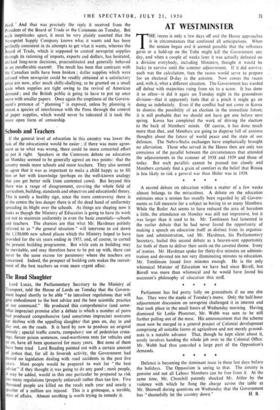Schools and Teachers
If the general level of education in this country was lower the task of the educationist would be easier ; if there was more agree- ment as to what was wrong, there could be more concerted effort to put it right. Speakers in the Commons debate on education on Monday seemed to be generally agreed on two points: that the country needs more schools and more teachers. They also seemed to agree that it was as important to make a child happy as to fill him or her with knowledge (perhaps on the well-known analogy that you get better milk from contented cows). But beyond this there was a range of disagreement, covering the whole field of curriculum, building, standards and objectives and educational theory. This is surely a healthy sign, since the more controversy there is at the centre the less danger there is of the dead hand of -uniformity spreading its blight over the schools. As things are shaping now it looks as though the Ministry of Education is going to have its work cut out to maintain uniformity in even the basic essentials—schools and teachers. The chances are that what Mr. Hardman politely referred to as " the general situation " will intervene to cut down the 1,150,000 new school places which the Ministry hoped to have provided for the six years ending in 1953, and, of course, to curtail the present building programme. But while cuts in building may be inevitable, and may therefore have to be put up with, there can never be the same excuse for parsimony where the teachers are concerned. Indeed, the prospect of building cuts makes the recruit- ment of the best teachers an even more urgent affair.


































 Previous page
Previous page